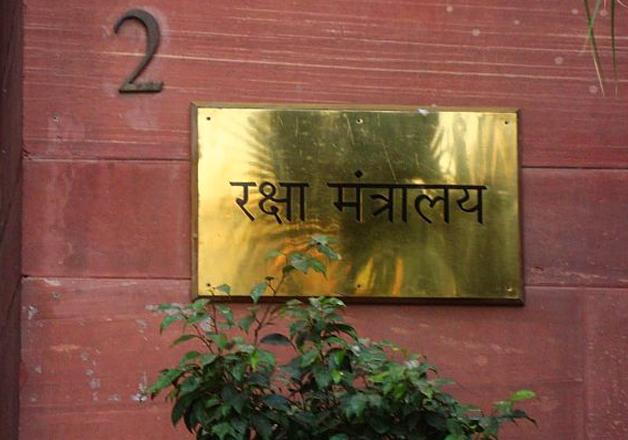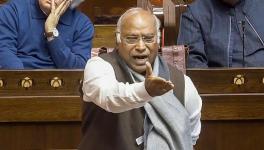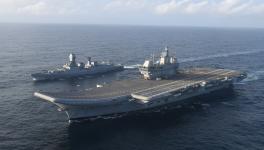Why Is MoD Keen on Debt-Ridden Reliance Naval’s Participation in Tenders?

The ambitious plan of the Ministry of Defence (MoD) to build four warships costing around Rs 26,000 crore has been in limbo for more than six years now, ever since it released a Request for Proposal (RFP) for the construction of Landing Platform Dock (LPD) class of ships for the Indian Navy. The purpose of the LPD ships is to carry helicopters, amphibious land war assets and personal carriers.
Indian private firms that are currently part of the bidding process are global construction giant Larsen and Toubro (L&T) and the Anil Ambani-headed Reliance Naval and Engineering Limited (RNEL), formerly known as Pipavav Defence and Offshore Engineering Company Limited and Reliance Defence Engineering Limited (RDEL).
In December 2013, the MoD released the RFP for three private Indian firms to build the four warships. These were L&T, Pipavav Defence and ABG Shipyards Limited (ABGSL). Larsen and Toubro tied up with Spanish ship builder Navantia, Pipavav with French company DCNS and ABG Shipyards with American company Alion, to participate in the tender.
The first two ships were to be built by an Indian firm in partnership with a foreign company which has the technical know-how to build warships. The remaining were to be built in partnership with Hindustan Shipyard Limited, a public sector undertaking under the MoD.
Soon after the RFP was released, Cochin Shipyard Limited (CSL), another government of India enterprise under the Ministry of Shipping, which has the largest ship-building yard in the country, expressed its interest to participate to the then Defence Minister AK Antony in the Congress-led United Progressive Alliance (UPA) government. The bidding process was temporarily put on hold by Antony.
In May 2014, the Narendra Modi-led National Democratic Alliance government came to power in New Delhi. In September 2014, the Defence Ministry announced that the Navy tender was only meant for private firms to bid.
Then, in early 2016, the Controller of Warship, Production & Acquisition, Integrated Headquarter, MoD, did not approve of ABGSL’s participation in the tender due to its poor financial health. The company had failed the corporate debt restructuring initiated by ICICI Bank. The company was in debt of around Rs 17,000 crore and is currently undergoing insolvency proceedings under the Insolvency and Bankruptcy Code. The MoD cancelled all contracts with ABGSL in June 2017 due to its poor financials.
This left only Pipavav and L&T in the race.
Interestingly, Pipavav also had a poor financial record. Even though the company’s financial health was not as bad as ABGSL, the company had close to Rs 7,000 crore debt towards the end of 2014 and was also under pressure from its creditors, led by IDBI Bank, to go in for corporate debt restructuring (CDR), which Pipavav was trying to avoid. However, on March 31, 2015, the Bombay Stock Exchange published on its website that Pipavav had informed them that their CDR Package (CDRP) had been accepted.
Reliance Takes Over Pipavav
On February 12, 2015, the Anil Ambani-led Reliance Infrastructure Limited informed the Bombay Stock Exchange that it had set up three wholly-owned subsidiaries -- Reliance Defence Systems Private Limited, Reliance Defence Technologies Private Limited and Reliance Defence and Aerospace Private Limited --to bid for defence projects.
In March 2015, it was announced that that the Anil Dhirubhai Ambani Group (ADAG) had taken 18% stake in Pipavav and another 26% would be taken over through an open offer that would give the ADAG management control over Pipavav. Commenting on the deal, Anil Ambani had said: “This is a unique opportunity for (the) Reliance Group to participate in Prime Minister Narendra Modi’s ‘Make in India’ programme for the high-growth defence sector.”
In March 2016, the name of Pipavav was changed to Reliance Defence and Engineering Limited.
Privatising Indian Defence
The Ministry of Defence released Chapter VII of the Defence Procurement Procedure (DPP) 2016 in May 2017, introducing a “Strategic Partnership (SP) policy.”
The terms of the LPD contract under the new SP policy was revised and L&T and RDEL were asked to submit fresh quotations for the four LPD ships, which was cleared by the Cabinet Committee on Security (CCS) in the same month.
The value of LPDs was now reported to be Rs 6,500 crore each, taking the total value of the deal to Rs 26,000 crore. The new policy also put Hindustan Shipyard out of the picture and all four warships were to be constructed by an Indian private firm in partnership with a foreign company.
Section 1, para 6 of the SP policy states: “The selection criteria for Strategic Partners (SP) will be based on the inherent capacity and ability of the vendor to emerge as a systems integrator and to set up a vendor network for sourcing. The criteria for selection should be fair, reasonable, non-arbitrary, transparent and rational, and based upon the broad parameters of financial strength, technical capability and capacity/infrastructure…”
Reliance Defence’s CDR Exit Plan
The 2015-16 annual report of RDEL mentions the company’s consolidated gross debt at the end of the financial year at Rs. 7,657.46 crore.
The auditors of RDEL had pointed out that as on March 31, 2016, the company had defaulted in repayment of loans to banks and financial institutions aggregating Rs 78.69 crore. However, the Indian Navy in 2016 had evaluated and approved the financial capabilities of the company to participate in naval tenders.
In April 2017, led by IDBI Bank, the creditors approved RDEL’s CDR exit plan and also gave permission for the implementation of the company’s refinancing plan. The CDR Empowered Group (EG) approved the refinancing of RDEL’s Rs 6,800 crore debt for a period of 20 years at a lower rate of interest. IDBI Bank wrote to the MoD informing it about the decisions of the CDR EG to make RDEL eligible to participate in defence contracts for the Indian Navy.
Out of the 25 RDEL creditors, it is interesting to note that the 20 financial institutions that participated in the CDR exit process comprised nationalised banks and two non-banking finance companies in the public sector. These were the Bank of India, Bank of Maharashtra, Central Bank of India, Corporation Bank, Dena Bank, Export-Import Bank of India, IDBI Bank, Industrial Finance Corporation of India, Jammu & Kashmir Bank, Karnataka Bank, Karur Vysya Bank, Life Insurance Corporation of India, Oriental Bank of Commerce, Punjab & Sind Bank, Punjab National Bank, State Bank of India, UCO Bank, Union Bank of India, United Bank of India and Vijaya Bank.
The five private creditors that did not participate were Housing Development and Finance Corporation (HDFC), Housing & Urban Development Corporation (HUDCO), India Infrastructure Finance Company (UK), IL&FS Financial Services and Yes Bank.
In 2015, Pipavav had not been allowed by the financial creditors to exit CDR. However, the CDR exit plan was approved by the same creditors in April 2017, when Reliance Infrastructure had taken over. This happened despite the company having a debt of Rs 6,800 crore.
RNEL Taken To NCLT
In September 2017, Reliance Engineering and Defence Limited changed its name to Reliance Naval Engineering Limited (RNEL).
Less than seven months after the CDR exit plan of RNEL was approved, in November 2017, the Delhi-based Industrial Finance Corporation of India (IFCI) initiated insolvency proceedings against RNEL and its subsidiary Reliance Marine and Offshore Limited for failing to service a loan it had extended to Reliance Marine & Offshore Limited -- RNEL was a corporate guarantor. IFCI was one of the two non-banking finance institutions in the public sector to have approved the CDR exit plan of Reliance Naval.
On November 30, 2017, RNEL issued a clarification to both BSE and National Stock Exchange: “In this regard, we would like to clarify that as legally advised, there are no merits in the application filed by IFCI before National Company Law Tribunal (NCLT), Ahmadabad, as it is an unsecured creditor. (sic). The action of IFCI is unwarranted and premature. The 25 secured lenders of the company have also requested IFCI that the matter be resolved outside NCLT. The company will take all necessary steps to safeguard the interests of all stakeholders.”
Then on December 20, 2017, V Satyavenkata Rao, Executive Director of IFCI, put out a press release that denied that any bank had requested the IFCI to settle the dispute outside the NCLT, that the loan is duly secured by a corporate guarantee of RNEL and that the amount worked out to Rs 159 crore.
There is no evidence in the public domain to suggest that RNEL has challenged the claims made by IFCI.
Nearly seven months after the exit of RNEL from CDR, the Union Bank of India and Vijaya Bank decided to classify loans to the company as Non-Performing Assets (NPA) during the last quarter of 2017-2018.
As 2017-2018 ended, things went from bad to worse for RNEL. The company’s auditors noted that there was “material uncertainty related to going concern” in the company. It had been incurring cash losses, its net worth had substantially eroded, loans had been called back by secured lenders, current liabilities were higher than current assets, applications had been made to NCLT and petitions had been filed before the Gujarat High Court for recovery of their dues by a few operating creditors.
The company booked a net loss of Rs 956.08 crore and had a total financial liability of approximately Rs 8,950 crore in the financial year.
In August 2018, ONGC terminated a contract with RNEL for the delivery of supporting vessels for offshore oil exploration and encashed the performance bank guarantee submitted by the ship builder. The contract, signed in 2008 with Pipavav, was for 12 vessels and public sector ONGC had taken the delivery of seven of them.
In December, the Indian Navy encashed the performance bank guarantee (PBG) given by the company for failing to deliver the offshore patrol vessels. This contract for five vessels was signed in 2011 and the delivery had to be completed in five years. While the company failed to deliver even a single vessel in five years, the Indian Navy did not cancel the contract in contravention of Chapter 6, Clause 12.1(a) of the Defence Procurement Manual 2009, which mandates the termination of a contract if “the supplier fails to honour any part of the contract including failure to deliver the contracted stores/render services in time.”
In January 2018, Reliance delivered the first two patrol vessels to the Navy that had to be delivered in November 2014.
The DPP Chapter VI, Standard Contract Document, Article 19, dealing with the termination of a contract, reads: “The BUYER shall have the right to terminate this Contract in part or in full in any of the following cases:- (a) The delivery of the material is delayed for causes not attributable to Force Majeure for more than (_ months) after the scheduled date of delivery. (b) The SELLER is declared bankrupt or becomes insolvent.”
How many months of delay was projected for the delivery of the offshore patrol vessels in 2011 when the contract was signed?
The Economic Times reported in July 2019 that the MoD invited the representatives of both L&T and RNEL for opening of commercial bids and after making them wait for more than an hour, informed them that the opening of the commercial bids had been postponed. The same report mentioned, “RNEL, which has originally bid for the contract in its earlier avatar as the Pipavav Shipyard, has filed an official complaint alleging a top Navy officer in charge of the selection process has been favouring L&T with confidential information. L&T has been pointing out the financial difficulties and debt restructuring issues that have afflicted RNEL, raising questions on its ability to complete the contract.”
On August 25, Anil Ambani resigned as the Director of RNEL and less than a fortnight later, on September 6, the lead lender of the company, IDBI Bank, filed an insolvency case with National Company Law tribunal (NCLT). In January 2020, almost 16 months after IDBI Bank had approached NCLT, the bankruptcy court admitted the insolvency plea.
According to DPP 2016, it is mandatory for a company to have a minimum of A or an equivalent rating to participate in ship-building contracts worth Rs 3,000 crore and above.
Ratings by global analytics company CRISIL, when RNEL was selected as one of the two private shipyards to participate in the LPD tender in 2017, was much lower. The ratings were CRISIL BBB+/Watch Negative for bond and non-convertible debentures and the rating was withdrawn for fund-based bank facilities. It seems the MoD violated the DPP 2016 norms when it asked RNEL to submit a revised proposal for LPDs.
The pertinent question to ask here is how did the MoD consider RNEL financially fit to take part in the tender?
On July 1, less than two months after the re-election of the Narendra Modi government on May 23, 2019, the MoD issued RFPs to five government and two private sector shipyards for 12 air cushion vehicles, eight fast patrol vessels and eight ammunition barges for the Indian Coast Guard and six next generation missile vessels for the Navy. The entire contract is worth nearly Rs 15,000 crore. RNEL was one of them. A press release states that the MoD has rationalised and promulgated the financial selection criteria to increase the number of participating shipyards and a capacity assessment has been done before issuing the RFP. Interestingly, the RFPs were sent to RNEL too.
And when the MoD issued RFPs to the company to participate in various ship-building programmes, another credit rating agency, Brickwork Ratings, had downgraded the company’s ratings from BWR D from its earlier July 2016 rating of BWR BB (RNR).
In a strange turn of events, in September 2019, the Indian Navy asked the MoD to cancel the RFPs for the LPDs altogether, citing that the specifications mentioned in the RFP were almost 10 years old.
During 2018-19, the company reported a loss of Rs 1,092.7 crore on a revenue of just Rs 180 crore. On January 10, The Hindu reported that the Anil Ambani-headed ADAG had defaulted on a Rs 43,800 crore loan as on December 31, 2019 and RNEL’s defaulted outstanding loan stood at Rs 9,491.96 crore. Many vendors of RNEL have also taken the company to NCLT for long pending dues.
A source closely associated with ADAG told this writer that since the insolvency petition filed by IDBI Bank in NCLT had now been accepted, there was nothing the company could do. The source believes that the company will not get any more contracts from the government or private companies.
However, despite the continued poor financial health of the company and even after two nationalised banks declared their loans as NPAs and two government-owned finance institutions taking the firm to NCLT, how did the MoD come to the conclusion that RNEL was financially healthy to participate in the naval tenders?
And, what if Reliance eventually gets the contract? Why has the LPD tender not been opened even after three years? Why is the MoD not terminating the signed contracts with the company even after its failure to deliver the products? Why has the RFP for LPDs not been recalled even after the Naval headquarter having written to the MoD more than four months ago?
Is the Narendra Modi government waiting for improvement in the financial health of the ship-building company owned by Anil Ambani, described by the Opposition as the Prime Minister’s ‘friend,’ at the cost of national security?
A detailed questionnaire was sent to the Defence Minister, Director General (Acquisition) and Additional Secretary and a spokesperson of ADAG. The story will be updated if and when they respond.
(Writing and research assistance: Sourodipto Sanyal)
The writer is an independent journalist.
Get the latest reports & analysis with people's perspective on Protests, movements & deep analytical videos, discussions of the current affairs in your Telegram app. Subscribe to NewsClick's Telegram channel & get Real-Time updates on stories, as they get published on our website.
























